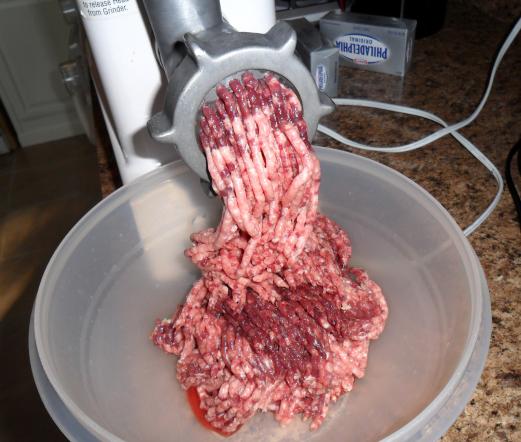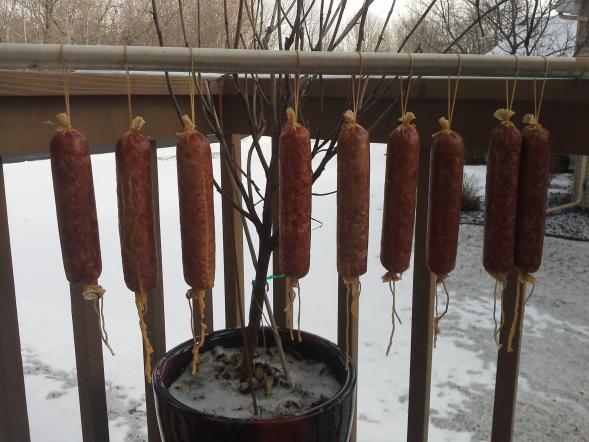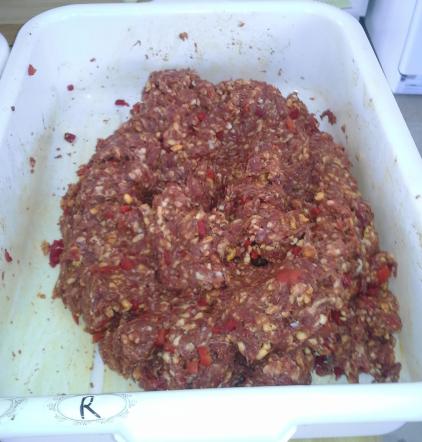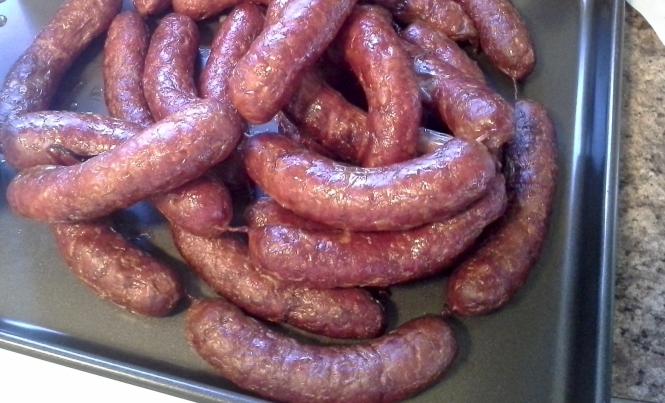This is the fifth post in a series about hunting for food -- truly meeting your meat. Also check out the earlier posts from the series: Squirrel Hunting with Mom, Duck Hunting, An Unsuccessful Pheasant Hunt, Mom Bags Her First Deer, and Ice Fishing.
From September 1st through the end of December, the majority of my free time is spent in the field in pursuit of wild game. Starting with dove hunting in September and ending with the archery deer season in December, I do all that I can to fill my freezer with wild game to eat for the rest of the year. But when the hunting seasons end, there is a period between January and April where there isn't much I can do. In April, the turkey hunting season opens up and there are lots of spring plants and mushrooms to forage. During this quiet period, I have found that one of my favorite pastimes is using the meat I that I have collected over the hunting season and turning it into sausage.
This last year was a good year for me. I managed to shoot two antelope in Wyoming, and I got two deer here in Minnesota. I also was able to put away some ducks, pheasants, and squirrels. I have roasts and steaks from the antelope and deer, but I also have a lot of scrap meat that isn't much good for the grill or fry pan. I use all of that meat to make sausages.
 Meat GrinderSausage
making is a fairly easy skill to learn, but it can be difficult without the
proper equipment and some basic knowledge. The first thing you will need is a
meat grinder; there are dozens of grinders on the market ranging from 70
dollars on up to several hundreds of dollars. If you own a kitchen aid mixer
there is a grinder attachment that you can purchase and it works very well. If
you only intend on making small batches of sausage, the attachment is a great
option. However, if you intend on making lots of sausages, I would recommend
buying a larger grinder that is capable of processing large amounts of meat.
Meat GrinderSausage
making is a fairly easy skill to learn, but it can be difficult without the
proper equipment and some basic knowledge. The first thing you will need is a
meat grinder; there are dozens of grinders on the market ranging from 70
dollars on up to several hundreds of dollars. If you own a kitchen aid mixer
there is a grinder attachment that you can purchase and it works very well. If
you only intend on making small batches of sausage, the attachment is a great
option. However, if you intend on making lots of sausages, I would recommend
buying a larger grinder that is capable of processing large amounts of meat.
The next piece of equipment that I would recommend is a sausage stuffer; a ten pound stuffer can be purchased for 70 to 100 dollars and will make stuffing your sausages a lot easier. Most grinders come with a stuffer attachment, but they are slow and can be bothersome to use. If you intend on making a lot of sausage, it is totally worth the money to buy a stuffer.
 Letting Sausages Hang Overnight (Step #4 in Recipe Below)Once you
have your basic equipment, sausage making is only as difficult as you want it
to be. It can be as easy as buying a kit that includes all the casings and
seasonings or as difficult as fermenting your own salami. The first thing to
figure out is what kind of sausage you want to make. There are thousands of
different types of sausages that can be made; many of them are specific to wild
game and the rest can be easily adapted to wild game.
Letting Sausages Hang Overnight (Step #4 in Recipe Below)Once you
have your basic equipment, sausage making is only as difficult as you want it
to be. It can be as easy as buying a kit that includes all the casings and
seasonings or as difficult as fermenting your own salami. The first thing to
figure out is what kind of sausage you want to make. There are thousands of
different types of sausages that can be made; many of them are specific to wild
game and the rest can be easily adapted to wild game.
Fresh sausages – which include bratwursts, Italian sausage, and Merguez – are a great place to start when making sausages. These sausages don’t require any smoking or curing before you eat them; all you have to do is fry them in a pan or throw them on the grill. The four basic components to fresh sausage are the meat, fat, salt, and seasonings. All of the sausages that I make are made from wild game. Venison and antelope don’t have a lot of fat to them, if any at all, so you have to add fat to the sausage yourself. I like to use pork back fat. Some people use beef suet, but I feel that pork fat has a milder flavor and doesn’t change the flavor of the wild game as much as beef suet does.
Whenever I make sausage using wild game, I use a 70/30 blend of meat to fat, meaning 70% meat and 30% fat. When making a five pound batch of sausage, that comes out to be 3.5 pounds of meat to 1.5 pounds of fat. I would use this blend to make sweet and spicy Italian sausage or Merguez. Other sausages like Bratwurst have a different blend of meats.
 Seasoned Sausage
Seasoned Sausage
Once you figure out your meat-to-fat ratio the next thing to add is salt. Too much salt can ruin your sausage, and too little will leave you with a bland tasting sausage. I use 40 grams of kosher salt, or about 3 tablespoons, per five pounds of meat and fat. The last step is the seasoning. You can create your own sausage or you can follow a recipe, it doesn’t matter. The great thing about making your own sausages is that if you like your Italian sausage to be hotter, you can make it hotter; if you like it with more garlic, you can add more garlic. You can tailor your sausages to your own liking.
This year I have made around 100 pounds of sausage already and have created three new sausages. I am very lucky because a lot of my friends will keep all their scrap meat for me, so I can make sausages and then give some to them and keep some for myself. A friend of mine hit two deer with his car and called the DNR to get permits for them, and we made 15 pounds of Mazzafegetti which is a northern Italian sausage traditionally made with wild boar or pig liver. We used the livers from the deer and it was amazing. After my trip to Wyoming I had around 40 pounds of antelope scraps to use, and I have made a sweet and spicy Italian sausage and a Merguez with most of that. I also made a smoked garlic and chipotle summer sausage that turned out amazing.
 My all-time
favorite sausage to make is a venison bratwurst. Brats are usually made with a
blend of veal and pork using more pork than veal; for my brats, I use venison
instead of veal and change the ratio, so I use primarily venison. Here is my venison
bratwurst recipe. If you have never made your own sausage, it is really a lot
of fun and can be a very rewarding hobby.
My all-time
favorite sausage to make is a venison bratwurst. Brats are usually made with a
blend of veal and pork using more pork than veal; for my brats, I use venison
instead of veal and change the ratio, so I use primarily venison. Here is my venison
bratwurst recipe. If you have never made your own sausage, it is really a lot
of fun and can be a very rewarding hobby.
Jamie's Venison Bratwurst
This recipe will make about 55 brats
Ingredients
4 pounds ground pork
6 pounds ground venison
3 eggs
1 pint whole milk (ice cold)
2 cups powdered instant milk
1 tablespoon ground white pepper
1 tablespoon mace
1 tablespoon nutmeg
1 teaspoon ginger
5 tablespoons salt
1 tablespoon onion powder
1 tablespoon garlic powder
1. Grind the venison and pork through a medium plate, meaning the holes on the grinding plate should be about a ¼ of an inch. Whenever you grind meat, it should be almost frozen; room temperature meat will not cut through the grinder and ends up getting mashed, which will produce a mealy texture in your sausage.
2. Mix all ingredients together completely, then let stand for a couple hours in the fridge.
3. After a few hours, fry up a patty to taste. Adjust seasoning as needed.
4. When seasoning is to your liking, stuff sausage mixture into pork casing and let stand overnight in a cool area with a good draft. You want the casing to dry around the meat (the casing will tighten up).
5. You can then boil your brats in your favorite beer and finish them on the grill.

Jamie Carlson lives in Burnsville, MN with his wife, Amanda, and their two kids Eleanor and Charlie. He works as an Rn at the Minneapolis VA hospital. He enjoys hunting, fishing, foraging, and, of course, cooking. He believes that all food can be tasty if it is prepared with care, and he writes about his adventures cooking everything from Pickled Venison Heart to Roasted Dove on his food blog, You Have to Cook it Right. Follow him at@youcookitright. His last post for SGT was Ice Fishing (and Salt Fish Brandade).

